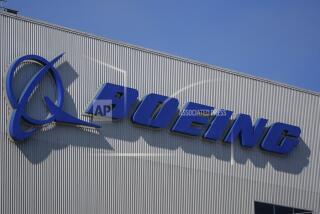Boeing to Focus on Space and Communications, Not Aircraft
- Share via
Boeing Co. will stake near-term growth on its Southern California space, communications and missile operations instead of commercial aircraft, which has long been the core of the company, Boeing executives said Thursday.
The commercial aircraft industry, dominated by Boeing, has traditionally counted on annual growth rates of 4% to 6% in air travel. Since the Sept. 11 attacks, aviation officials anticipate a 20% drop in air travel.
As much as $35 billion of Boeing’s annual $57 billion in revenue comes from its commercial aircraft business, with the balance coming from its rocket, satellite, missile and military aircraft businesses.
Over the next three to five years, Boeing Vice Chairman Harry Stonecipher said, the percent of revenue from commercial aircraft will shrink to less than 50%.
“You are going to see a switch--where commercial aircraft will still be very large, but the others will see growth,” Stonecipher said.
Boeing, which moved its headquarters this summer from Seattle to Chicago, is aggressively trying to prove to investors that it is more than a commercial aircraft company.
As commercial aircraft business stays soft, the company is likely to focus more on its plants in Southern California, the base of its space and communications units, which employ 43,000 workers. The company also builds its 717 airliners and C-17 military transport planes in Southern California.
Stonecipher and Jim Albaugh, president and chief executive of Boeing Space & Communications in Seal Beach, met with reporters to update them on the company.
Boeing already has announced plans to lay off as many as 30,000 of its employees. Stonecipher said he did not expect that number to change. None of the Southern California workers are included in the layoff plan.
The near term will be decisive for Boeing. Its next-generation rocket, the Delta 4, is slated for launch in April 2002, and the Pentagon will announce Oct. 26 who will build the Joint Strike Fighter, either Boeing or Lockheed Martin Corp.
The deal to build as many as 6,000 of the next-generation warplanes could be worth well in excess of $200 billion. Versions of the aircraft, based on a common design, will serve the U.S. Navy, Air Force and Marines as well as Britain’s Royal Navy.
The all-or-nothing contract will not harm Boeing’s bottom line if Lockheed is selected.
“Win or lose, it won’t have a big impact in the near term. It will have an emotional impact. It will have a stock impact,” Stonecipher said.
Boeing said it will press ahead with development of the Sonic Cruiser, a 200- to 300-passenger airliner that would fly just under the speed of sound at altitudes about 10,000 feet higher than current airliners typically fly. The jet is slated to fly around 2007.
It is an answer to Airbus Industrie’s A380, a super-jumbo jet that will seat 555 passengers and is to go into service in 2006.
“It’s going ahead as planned,” Stonecipher said.
The company expects to see growth in its work on building a national ballistic missile defense program as well as commercial satellite, missile and air traffic management businesses.
The company is also involved in retrofitting or boosting security equipment for existing airliners, but that work is not expected to have a major impact on revenue.
Plans for broadband, Web and e-mail access for passengers on carriers are expected to be delayed.
Boeing shares added 42 cents to $36.18 on the New York Stock Exchange on Thursday.
More to Read
Inside the business of entertainment
The Wide Shot brings you news, analysis and insights on everything from streaming wars to production — and what it all means for the future.
You may occasionally receive promotional content from the Los Angeles Times.










